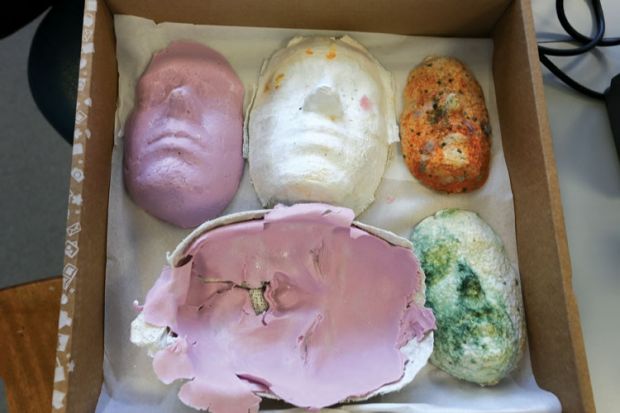Lively countenances: face casts, now with active bacteria
Animated spirographs and bacterial portraits were among the projects under discussion at a seminar exploring the potential and the challenges of “integrating art and science” within learning.
Set up at the University of Westminster in 2010 as an extracurricular programme, the Broad Vision project brings together 30 to 35 arts and science students each year on Friday afternoons from January to April. Their very different knowledge and skill sets mean that everyone is both an expert and a novice, so they form into small groups to create science-inspired artworks. By the end of the very first year, in which a focus on microscopy was encapsulated in the theme The Art and Science of Looking, the collaborations had led to an exhibition, workshops, a seminar and a book.
After two successful trial years, Westminster turned the programme into an optional credit-bearing module for second-year students on a range of courses, with others attending on an extracurricular basis. Some of the results were presented at Learning Across Disciplinary Divides: Integrating Art and Science Through Emergent Curriculum Design, a Higher Education Academy seminar held on 20 November.
Benjamin Palmer (human and medical sciences) said he had expected that a collaboration with fellow final-year student Robbie Duncan (illustration and visual communication) would be “a three-month tug of war, but it became a three-month relay race” instead. The experience “completely changed the way I looked at science, turning information into knowledge I could share with others”.
Mr Duncan described their efforts to make “something that would light up without using electricity”, which led him on to modelling images of coral reefs through animated spirographs. He stressed the value of “an exchange of working environments” and noted that “donning a white coat makes you feel a little bit more of a scientist”. Even his memory stick was now much more organised, he added.
Mark Clements, lecturer in biosciences at Westminster, and Mell Fisher, a recent graduate in illustration, recalled a Broad Vision taster session in which some science students demonstrated how to test the efficacy of antimicrobial gels by making before and after fingerprints in agar.
That led Ms Fisher to wonder, she told delegates, whether “it was possible to make 3D sculptures out of agar”. Dr Clements had no idea but said his head of department “went pale when I said that a group of art students wanted to make agar sculptures with living bacteria”.
Nonetheless, they decided to try, making jelly moulds out of agar and then swabbing their ears, noses and eyebrows for bacteria. They went on to produce casts of their faces and smear them with microbes. These were put in an exhibition and three are on display in Dr Clements’ lab with the bacteria still growing, piquing colleagues’ curiosity.
The work, he said, “not only has artistic merit” but “scientific validity as well…I have been contacted by the European Centre for Disease Prevention and Control, which is interested in developing this as a tool to educate the public on the issues of antibiotic resistance in bacteria”. Future plans include “a full-body microbiological sculpture”.




